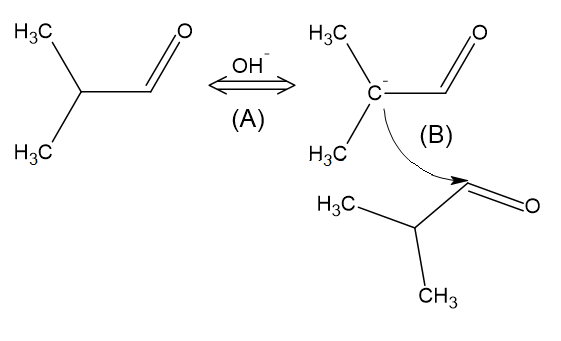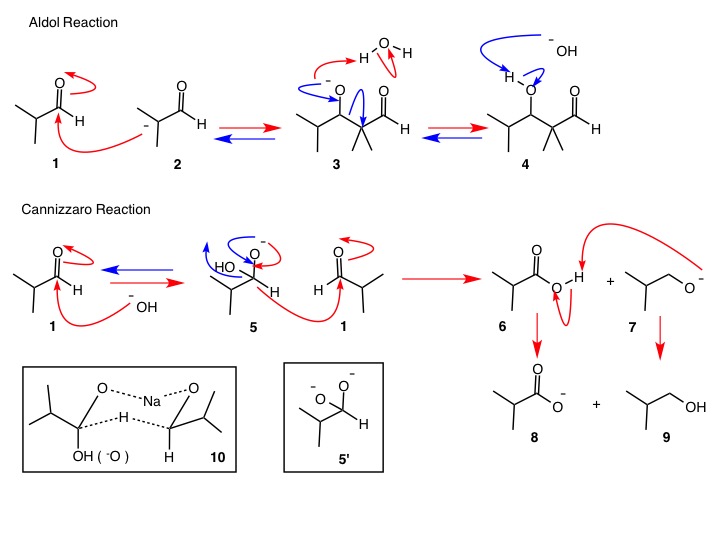Why does 2-methylpropanal undergo a Cannizzaro reaction even though it has an $\alpha$-hydrogen?
5 Answers
There is never an either–or in chemistry; it is typically a both instead. In the case of a hydroxide ion approaching an aldehyde with an α-hydrogen, it can both deprotonate the hydrogen creating the corresponding enolate and attack the carbonyl nucleophilicly to generate the required intermediate for a Cannizzaro reaction.
Most of the time, if there are two (or more) possible pathways and neither of them is intrinsically less hindered due to a strong reason, both pathways will be taken.
-
1$\begingroup$ So what is the major product ? The one formed due to Cannizaro or Aldol ? Is there any way to predict this in general or are such results mostly usually only experimental ? $\endgroup$ Commented Dec 26, 2016 at 9:14
-
3$\begingroup$ @UtkarshGupta You definitely can’t predict it a priori. It will also depend a lot on the reaction conditions, some making it lean more towards Cannizzaro, others more towards aldol. Thus, the results are experimental (and researchers subsequently attempt to rationalise them). $\endgroup$– JanCommented Dec 26, 2016 at 10:51
I have to agree with Jan's answer here, that the final results will always be experimental. But, having not found any conclusive answer on the internet anywhere, and that this result comes up often, I believe a theoretical answer would help, so here it is:
The average textbook will commonly write:
2-methylpropanal undergoes the Cannizaro reaction even though it has an alpha hydrogen atom.
Now, what they mean to say, as Jan already pointed, is that Cannizaro is a major product (and not the only product). Why is it a major product? Let us see:
(I hope you are familiar with both aldol and Cannizaro mechanisms clearly. If not, click those links first)
First off, just because there is an alpha hydrogen atom here, does not mean that 2-methylpropanal cannot undergo Cannizaro reaction. In fact, it can very well undergo the Cannizaro reaction, and you would face no problem in drawing out the corresponding products for it. Try it out!
However, there will be a problem if you do aldol condensation with 2-methylpropanal. Have a look at the first two steps:
Step A is fine. The enolate is slightly unstable due to being a third degree carbanion, but it's not the problem. The problem actually is step B. The nucleophilic site here is a 3 degree carbanion and that presents severe steric hindrance here.
Hence, due to step B being sterically hindered, the aldol product ends up being a minor product, giving the major product title to the Cannizaro product instead.
-
$\begingroup$ "The enolate is slightly unstable due to being a third degree carbanion": the enolate ion will have most of the negative charge on the oxygen (another resonance structure which you haven't shown here), so I would argue that the resonance structure you have shown being a three degree carbanion would make negligible difference to the stability. $\endgroup$ Commented Dec 21, 2021 at 14:54
-
$\begingroup$ @AshishAhuja There is an important mistake you have done. Basicity is a thermodynamic concept whereas nucleophilicity is a kinetic concept. Stability plays less role here. The main thing is that steric hindrance makes it difficult to form aldol product, so aldol reaction will be slower. So cannizaro product is definitely KCP. But I can't say about TCP $\endgroup$– RitilCommented Jul 23, 2022 at 5:04
-
$\begingroup$ @Ritil I never said that aldol reaction here will not be slow; I agree that due to steric hindrance it will be difficult to form aldol pdt. I just pointed out that a certain line in the answer (which I have quoted in my original comment) is not logical. $\endgroup$ Commented Jul 23, 2022 at 13:36
I would like to join this conversation and hopefully codify some of the ideas presented. First, the Cannizzaro reaction is generally conducted under more vigorous conditions than that are required for an aldol reaction or aldol condensation (when water is lost to form an enone or enal). I would hazard to guess that Cannizzaro studied only aromatic aldehydes. But if isobutyraldehyde ($\bf{1}$) and base afford disproportionation products isobutyric acid ($\bf{6}$) and isobutyl alcohol ($\bf{9}$), then it is safe to say it is a Cannizzaro reaction (if it quacks like a duck and walks like a duck...).
Assuming the reaction is being conducted in aqueous $\ce{NaOH}$, the enolate $\bf{2}$ of isobutyraldehyde $(\bf{1})$ is formed reversibly. The aldol product $\bf{4}$ may form to some extent via alkoxide $\bf{3}$ (follow the red arrows.) Aldol $\bf{4}$ cannot eliminate water under the reaction conditions because the α-position has no hydrogens available for elimination. Aldol $\bf{4}$ is a known compound prepared under other conditions (acid catalysis with Dowex-50). If it were subjected to the reaction conditions under consideration, it would undergo retro-aldolization to afford isobutyraldehyde (blue arrows) [continued].
So isobutyraldehyde cannot escape its ultimate fate --- the irreversible Cannizzaro reaction. While hydroxide adds reversibly to the carbonyl group of isobutyraldehyde to provide alkoxide $\bf{5}$, transfer of hydride to isobutyraldehyde is irreversible (red arrows; its all downhill from here!). The bis-alkoxide $\bf{5}$ has been suggested as the active hydride transfer species. The immediate products are isobutyric acid ($\bf{6}$) and the alkoxide $\bf{7}$. Proton exchange as shown for economy of space but more likely via the agency of aqueous $\ce{NaOH}$, gives the respective carboxylate $\bf{8}$ and isobutyl alcohol $\bf{9}$. If these two species are independently subjected to the reaction conditions, isobutyraldehyde will not be formed. Moreover, treatment of aldol $\bf{4}$ under the reaction conditions will also channel itself into the anion of isobutyric acid ($\bf{8}$) and isobutyl alcohol ($\bf{9}$).
Diagram $\bf{10}$ represents a possible transition state for the hydride transfer. A concerted mechanism obviates the questionable existence of hydride in aqueous solution.
2-Methyl propanal with only one alpha-H can undergo Aldol reaction, the next step condensation to eliminate water molecule requires another alpha-H which is not available in case.
While Aldol is a reversible reaction, much of the chances to get is backwards exist.
On the other hand, if hydroxide attacks aldehyde group, leading a way to Cannizzaro: the step-II, hydride transfer to another aldehyde is 'irreversible'.
Verdict: Aldehydes with just one alpha-H do not prefer Aldol; they rather proceed to Cannizzaro.
-
$\begingroup$ There still is another alpha hydrogen from where another alkene could form, and a condensation could still occur. So, I disagree with your first point. Secondly, could you clarify your meaning with "hydride transfer to another aldehyde is 'irreversible'." If it is irreversible, so what? Do you mean to imply that the concentration of all Cannizaro products will increase with time (because they are irreversibly formed)? Going by this logic, why can't we say that all reactions - even those with major aldol - will eventually arrive at Cannizaro as the major product? Thanks! $\endgroup$ Commented Mar 16, 2018 at 12:15
Referring to Jans answer one might ask for a reason that in the case of 2-methyl-propanal the canizzaro reaction gets favoured over the aldol reaction in comparison to other $\alpha$-deprotonizable aldehydes.
Take a look at the intermediate of the aldol reaction: You will get a trifold substituted carbo-anion, which is quite unfavourable in terms of stability. (Talking basic conditions as these are also required for canizzaro reactions)
-
1$\begingroup$ No, if you put the charge on the oxygen in line with the most favoured resonance depiction, you have a trisubstituted double bond which is rather stable. $\endgroup$– JanCommented Nov 9, 2017 at 13:00


